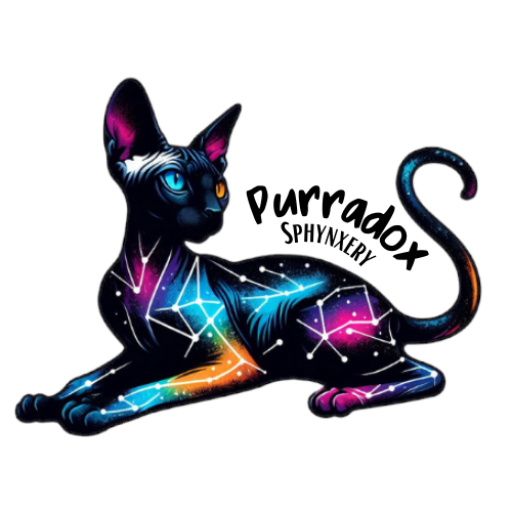Sphynx Cat Care and Adoption FAQs
Frequently Asked Questions
Welcome to Purradox Sphynxery’s FAQs Page
At Purradox Sphynxery, we know that welcoming a new Canadian Sphynx kitten into your home is a big decision. Whether you’re a first-time Sphynx cat owner or a long-time enthusiast of hairless breeds, you likely have plenty of questions. Our FAQ page is designed to provide you with clear, comprehensive answers to the most commonly asked questions about our cats, breeding practices, adoption process, and ongoing care. We are committed to helping you make informed decisions and ensuring that you and your new feline companion are well-prepared for a lifelong bond.
This FAQ section is divided into several key categories, allowing you to quickly find the information you need:
- Sphynx Cat Care – Tips and advice on how to groom, feed, and maintain the health of your Sphynx. These hairless cats have unique care needs, from regular ear cleaning to proper nutrition, to keep their skin healthy.
- Breeding & Adoption – Learn about our breeding practices, adoption process, and what to expect when bringing a new kitten home. We believe in ethical and responsible breeding, focusing on the health, temperament, and well-being of every kitten.
- Sphynx Cat Health – Discover insights into common health concerns specific to Sphynx and other hairless breeds, including heart health and genetic testing. We prioritize the well-being of our kittens and take extensive steps to ensure they are in peak health before they go to their forever homes.
- Sphynx Cat Behavior – Explore the fascinating and affectionate nature of Sphynx cats, with tips on socialization, training, and understanding their playful yet cuddly personalities.
- Sphynx Kittens – A detailed look at kitten care, development stages, and what you can expect as your new kitten grows. We provide guidance on feeding, litter training, and preparing your home for a Sphynx kitten.
Frequently Asked Questions
Why We Created This FAQ Page
We understand that choosing the right cat for your family is a personal and often overwhelming decision. As a reputable breeder and advocate for the Sphynx breed, we are dedicated to transparency, education, and ethical practices. Our FAQ page is meant to be a resource for anyone curious about these unique and loving cats. Whether you’re considering adopting from Purradox Sphynxery or are simply a fan of hairless breeds, our goal is to provide accurate and up-to-date information to help you care for your cat with confidence.


